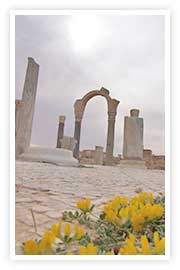
The city of Sabrata is located on the Mediterranean coast, one-hour drive west of Tripoli. It was founded by the Canaanites in the 6th century BC. A Phoenician trading-post that served as an outlet for the products of the African hinterland, Sabrata was part of the short-lived Numidian kingdom of Massinissa before being Romanized and rebuilt in the 2nd and 3rd centuries A.D. Like Leptis Magna, Sabrata began as a settlement to service the coastal trade of the Carthaginians. It was developed as a permanent site in the 4th century BC to act as a terminal for the trans-Saharan trade since it had a natural harbor on an otherwise long and unindented coastline. The site was later to become of the 3 cities with Leptis and Oea (Tripoli).
Sabrata prospered in the third century AD as a trading place for the Ivory coming from central Africa, through Ghadames and Fezzan. The Vandals who invaded North Africa from Europe abandoned it after its destruction. In 533 AD the Byzantines occupied the city and rebuilt most of it noticeably, the church of Justinian with its fine decorated mosaic floors.
Amongst the walls and foundations of public buildings discovered in the city, are the market, tribunal and some temples. Among the most prominent features of the city during Roman times are the public arenas, the Temples of Liber Pater, Sirapis, Isis, and Hercules, the forum, the theatre, the tribunal arena, and the public paths. Ruins of the earliest Phoenician settlements have been found beneath the Roman town in the area between the forum and the Sea.
The main monument is the Amphitheatre, used in modern times as a theatre and concert hall. There is a variety of public baths, temples and fountains, with many first class mosaics both on site and in the adjacent Museum, Some Byzantine remains are on show to exemplify the revival after the Vandal invasions.
Sabrata is also a UNESCO World Heritage site.
(source : www.libyaonline.com)
|

